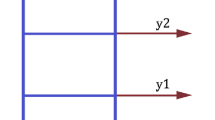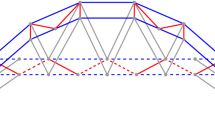Abstract
In this paper, test verification for a method of damage identification using artificial neural network (ANN) based on statistical properties of structural dynamic displacements was carried out. Six fixed beam models are fabricated, and damages on them are simulated by cutting a crack at their bottoms. Some damage samples were used to train the neural network and other samples were used to check the well-trained neural network. During the damage identification using back-propagation neural network (BPNN), the changes of variances (covariance) of structural displacements were adopted as input and location and extent of damage were as the output of BPNN. From the results of test verification in both single-damage case and multi-damage case, it is found that the ANN with the statistical property as damage index can accurately detect the damage location and can identify the damage extent with high precision, which denotes that the proposed method is effective and reliable for damage identification in civil engineering.





Similar content being viewed by others
References
Bishop CM (1994) Neural networks and their applications. Rev Sci Instrum 65(6):1803–1832
Dems K, Turant J (2011) Structural damage identification using frequency and modal changes. Bull Pol Acad Sci 59(1):27–32
Elshafey AA, Haddara MR, Marzouk H (2010) Damage detection in offshore structures using neural networks. Mar Struct 23(1):131–145
Geng X, Lu S, Jiang M, Sui Q, Lv SH, Xiao H, Jia Y, Jia L (2018) Research on FBG-based CFRP structural damage identification using BP neural network. Photon Sens 8(2):168–175
Jiang S-F, Zhang C-M, Zhang S (2011) Two-stage structural damage detection using fuzzy neural networks and data fusion techniques. Expert Syst Appl 38(1):511–519
Kaveh A, Dadras A (2018) Structural damage identification using an enhanced thermal exchange optimization algorithm. Eng Optim 50(3):430–451
Lew J-S (2011) Structural damage identification with performance-based uncertainty quantification and feedback control. J Intell Mater Syst Struct 22(8):1317–1325
Li Z-X, Yang X-M (2008) Damage identification# for beams using ANN based on statistical property of structural responses. Comput Struct 86(1–2):64–71
Lu ZR, Zhu JJ, Ou YJ (2017) Structural damage identification using incomplete static displacement measurement. Struct Eng Mech 63(2):251–257
Machavaram R, Shankar K (2012) Structural damage identification using improved RBF neural networks in frequency domain. Adv Struct Eng 15(10):1689–1703
Mukhopadhyay T, Chowdhury R, Chakrabarti A (2016) Structural damage identification: a random sampling-high dimensional model representation approach. Adv Struct Eng 19(6):908–927
Pathirage CSN, Li J, Li L, Hao H, Liu W, Ni P (2018) Structural damage identification based on autoencoder neural networks and deep learning. Eng Struct 172(10):13–28
Teixeira JS, Stutz LT, Knupp DC, Silva Neto AJ (2017) Structural damage identification via time domain response and Markov Chain Monte Carlo method. Inverse Probl Sci Eng 25(6):909–935
Yang Y, Nagarajaiah S (2014) Structural damage identification via a combination of blind feature extraction and sparse representation classification. Mech Syst Signal Process 45(1):1–23
Zhang QW (2007) Statistical damage identification# for bridges using ambient vibration data. Comput Struct 85(7–8):476–485
Zhang CD, Xu YL (2016) Structural damage identification via multi-type sensors and response reconstruction. Struct Health Monit 15(6):715–729
Zong Z, Niu J, Wang H (2012) A review of structural damage identification methods based on the finite element model validation. China Civ Eng J 48(8):121–130
Acknowledgements
The authors acknowledge the financial supports from the National Natural Science Foundation of China (Grant Nos. 50278064 and 51008148) and the Natural Science Foundation of Liaoning Province, China (Grant No. 20170540414).
Author information
Authors and Affiliations
Corresponding author
Additional information
Publisher's Note
Springer Nature remains neutral with regard to jurisdictional claims in published maps and institutional affiliations.
Rights and permissions
About this article
Cite this article
Yang, X., Chen, X. Test verification of damage identification method based on statistical properties of structural dynamic displacement. J Civil Struct Health Monit 9, 263–269 (2019). https://doi.org/10.1007/s13349-019-00331-0
Received:
Accepted:
Published:
Issue Date:
DOI: https://doi.org/10.1007/s13349-019-00331-0




